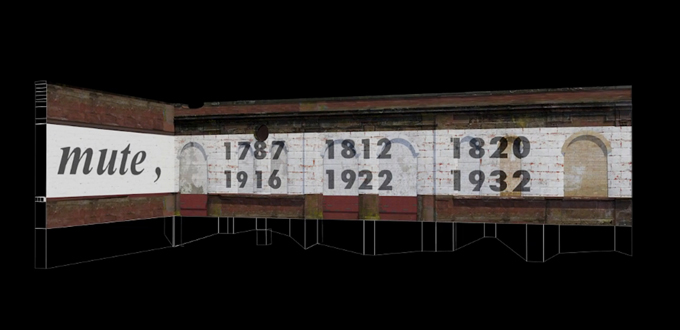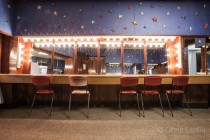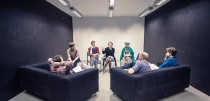
Still from Michael Mersinis’s 3D model of Glasgow Green Station
Stations of the Green was an exhibition at the New Glasgow Society Gallery on display from 26 April – 17 May 2013. The following review is by M.Res Glasgow School of Art student, Peter Drew.
There’s a great bit of footage from 1965 in which Bob Dylan meets a devout fan who asks Dylan the ‘meaning and philosophy’ behind the T-shirt he wore on a recent album cover. With enough wide eyed sincerity to make anyone wince, the fan unfolds his intricate theories only for Dylan to reply “I don’t really remember too much about it” with a mixture of amusement and fear at a fan clearly intoxicated with idolatry. I like to imagine that Douglas Gordon might react similarly to Stations of the Green if it were ever brought to his attention.
In 1990, the same year that Glasgow was wishfully dubbed the European city of culture, Douglas Gordon paid some other artists to paint 6 dates on an abandoned railway station along with the word ‘Mute’. At the time no one really knew what it meant and cared so little that by 1996 the site of the mural had become overgrown with vegetation. However, that same year Gordon won a prize that was fast becoming the main P.R. engine of British Contemporary art. Interest in the mural began to grow until now, 17 years later, Stations of the Green presents an exhibition dedicated to its memory. Such is the gilded light cast upon the Turner Prize recipient that it illuminates not only their future but also their past.
Last year the ruins of the Glasgow Green Station, upon which the mural was painted, were demolished, prompting curators Johnny Rodger and Mitch Miller to sift through the wreckage. Around the time of the demolition the BBC were in town making The Grit and the Glamour, in which Alan Yentob (jolly culture guy) fawns over the city’s contemporary art starts in a struggle to inflate the myth of the ‘Glasgow miracle’ without fainting. ‘Miracle’ because Glasgow’s identity was meant to be drenched in blue-collar authenticity, which isn’t very arty, right? But in the 90s it fit perfectly with the ‘brash rebel’ cliche of the Cool Britannia brand. So when Gordon’s mural was about to come down you’d think Alan Yentob and his BBC crew would be all over it, but no. Apparently Glasgow’s shrug of indifference at the mural’s destruction might have conflicted with the documentary’s premise that the ‘Glasgow Miracle’ had something to do with Glasgow.
So what is this mural all about? A general consensus holds that the dates refer to significant events in the city’s history of the labour movement that took place on or around Glasgow Green. The problem is that Gordon has never really confirmed this theory which leaves the door wide open for a long game of forensic inquiry. So, like an episode of Taggart, Stations of the Green is on the case.
Curator Johnny Rodger traces the last three dates to an essay by John Taylor Caldwell titled ‘The Battle for The Green’ published in a Workers City publication in 1987. According to the essay a bye-law was passed in 1916 that banned almost any form of public gathering that could be employed to political ends. The law was actually enforced in 1922 and finally revoked in 1932. A perfect match! This clue even suggests an explanation for Gordon’s use of the word ‘Mute’ in the fact that the law suppressed discourse. Rodgers goes on to postulate that ’1820′ refers to The Scottish insurrection.
The last two dates are harder to nail down. In fact you start to wonder “why am I nailing down dates at all”. Rodgers suggests that the whole thing might be a parody of the reductive practice of memorialising entire dates via public inscription. With typography so stark and authoritarian you might even hope that the mural is a parody. But it seems more likely to just be as critic Craig Richardson states that the dates suggest an alternative to the ‘centrally validated view of Glasgow’s history.’ I didn’t realise there was a ‘centrally validated’ view of Glasgow’s history but I guess it could be fun to imagine you were rebelling against one.
Aside from the wealth of investigative documentation, the exhibition includes responses to the mural in the form of new artworks. Photographer Michael Mersinis has captured some beautiful black and white textures of the earth where the wall fell that convey the violence of erasure and the sterility that remains.
Illustrator Mitch Miller dérived his way around Glasgow Green and produced a series of songlines that imagine the spiritual connection to the places where protestors marched and fought and sang.
Behind a dark curtain at the back of the exhibition rests a stone autopsy in the form of three large fragments from the wall itself. Recovered from a council depot in Shettleston, these six letters from the Glasgow Gr-EE-n Sta-TI-ON sign convey just how big the wall actually was. The letters set the structure of a haunting musical composition by Stephen Davismoon that plays in the room. A projected 3D model of the mural by Michael Mersinis (pictured above), spins on the wall.
Like a great cover on a bad album, I enjoyed this exhibition but not the memory of Gordon’s mural. Despite the riches of documentation provided, the mural still seems stark and craft-less to the point that the two men who were hired to actually paint the thing could barely remember doing so. Such a minimal approach might have worked if the concept was stronger or if the subject matter of the labour movement didn’t have its own visual traditions that Gordon chose to ignore. Gordon’s former lecturer David Harding might have been right in his belief that, when it comes to public art, “context is half the work” but there’s still the other half. The dates allow the mural a piggy-back ride on the significance of past events to which it contributes little besides the necessary amount of ambiguity to satisfy an insider audience’s habit of fondling their own interpretations. All this is brilliantly captured by Stations of the Green, an exhibition I enjoyed very much for many reasons, not least of which was the assistance it gave me in realising my distaste for the mural itself.
Written by Peter Drew
Read more by Peter Drew on Central Station here.
More: Website | Facebook | Twitter
//////
Want to read more blogs by artists? Look here.














Comments